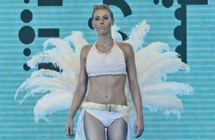牛粪时装:荷兰设计师将牛粪改造成时装
很多人身上的化纤衣服都是石油做成的,那么牛粪做成的衣服你穿过吗?你的第一反应可能是这种衣服会不会臭不可闻。放心,就像化纤衣服上闻不到石油的味道,牛粪时装也不会保留那种臭烘烘的原始味道。一起来了解一下吧!
With cattle breeding at an all time high, manure has become one of the world’s greatest environmental hazards, but one Dutch artist is using chemistry to turn into something that is both eco-friendly and valuable. Her innovative technique turns manure into a variety of useful materials like clothing fabric, bio-degradable plastic and paper.
因为全球畜牛量一直保持在很高水平,所以牛粪已经成为了世界几大环境公害之一。但现在,荷兰一位设计师正在运用化学原理将牛粪转化成对环境无害的有用之物,例如服装面料、生物可降解塑料以及纸张。

In recent years, scientists around the world have made great progress in their attempts to recycle cattle manure, including turning it into natural fertilizer and biogas, but Eindhoven designer Jalila Essaïdi didn’t think they were efficient enough to solve the global manure surplus problem. So she started on her very own solution, one that approached animal waste as a valuable material that could be processed into useful products. The results of her work prove that manure really is worth its weight in gold.
最近几年,全球各地的科学家都在牛粪回收问题上获得了不错的成果,比如把牛粪转化成天然肥料和沼气。然而,荷兰埃因霍温市的设计师贾丽拉•埃塞迪并不认为这些手段足以解决全球牛粪过量问题。因此,她开始自己研究解决方法,希望能让动物粪便变成可再利用的产品原料。贾丽拉的研究结果表明,粪便的确有利用价值。
Working in her BioArtLab, Jalila Essaïdi discovered that cow manure provided both the base for a new, bio-degradable material and the chemicals required to produce it. She started by separating the waste, with the dry manure used to extract pure cellulose from the grass that cows eat. From the wet manure, she extracted acids used to create cellulose acetate, a natural liquid plastic. This was used to make fibers, which are later turned into fabric or bio-plastics, but it can also be freeze-dried to create an aerogel.
在她的生物艺术实验室里,贾丽拉•埃塞迪发现牛粪可以为一种新的、生物可降解物质提供主要成分和化学原料。她从分离粪便开始,将干粪中的纯纤维素提取出来,这些纤维素来自牛所吃的草。她还从新鲜的粪便中提取出用于制作醋酸纤维素这一天然液体塑料的酸类物质。醋酸纤维素可以用来制作纤维,纤维又是生成布料和生物塑料的原料。醋酸纤维素还可以通过冷冻干燥生成气凝胶。
The new material was named Mestic, from mest, the Dutch word for manure. Essaïdi claims that it has the same properties as plastic derived from fossil fuels, but is bio-degradable. Better yet, the degradability can be tweaked in the lab, making it possible to create materials that last for different periods of time depending on their purpose.
这种新物质被命名为Mestic,因为荷兰语中的粪便一词写作mest。埃塞迪解释道,它的原理与石油衍生物塑料一样,不同的是新物质是生物可降解的。更好的是,这种可降解性通过实验室处理可以改变,从而使原料的降解属性根据不同目的做出不同调整。
“This is not the first time that scientists are looking for ways to solve the manure problem, but it is the first time that manure is being considered as a valuable resource,” the Dutch designer said.
这位荷兰设计师说:“这并不是科学家第一次致力于寻找解决粪便问题的途径,但把粪便当做是有利用价值的资源,这确实是第一次。”
Last year, Jalila Essaïdi partnered with the municipality of Eindhoven to produce a fashion show using Mestic-based fabrics. Her Mestic couture collection was so impressive that clothing giant H&M awarded her the Global Change Award and a $1 million prize. And just in case you’re wondering, no, manure-derived clothes don’t stink.
去年,贾丽拉•埃塞迪同埃因霍温市市政局联合主办了一场时装展,展示由Mestic制成的衣料。贾丽拉的粪便时装展引起了巨大轰动,服装界巨商H&M因此颁发给了贾丽拉“全球改变奖”和100万美元奖金。关于这种时装是否有恶臭的问题,大家也无需担忧,粪便时装完全没有臭味。
Essaïdi now plans to increase Mestic production and work on making it usable in 3D printing, but that requires a bit more research to tweak its melting temperature. She also intends to use the material to build a bridge in her home city of Eindhoven to further showcase the versatility of this innovative invention.
埃塞迪现在计划扩大Mestic的产量并尝试把它运用在3D打印上,但这需要在改变其融化温度方面开展更多研究。她还打算在家乡埃因霍温市用这种材料建一座桥来进一步展示她的这一创造发现具有多种功能。
And cow manure is just the beginning of Jalila Essaïdi’s experiments with animal waste. “After cows, we’ll tackle pigs and other animals,” she told Dezeen. “And after that? Who knows.”
牛粪仅仅是贾丽拉•埃塞迪对动物粪便进行研究的开始。她告诉Dezeen(全球最具影响力的建筑设计博客网站):“研究完牛粪之后,我们将研究猪粪和其他动物的粪便。要说这之后的计划,谁知道呢?”